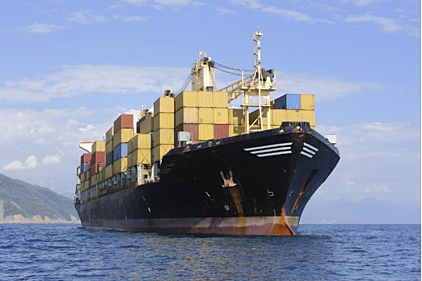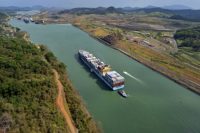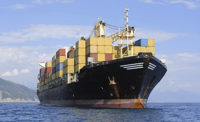One cannot understate the scale and impact of the $5.25 billion Panama Canal expansion project. When completed and operational in 2016, it will add a deeper and wider third lane and a new system of locks to accommodate new massive vessels.
Developments surrounding this project are of great interest to companies involved in the cold chain. Many handle products that that are shipped in refrigerated containers on vessels navigating the Panama Canal.
And, while there’s little doubt trans-shipment activity through Panama will grow once the expansion of the Panama Canal is completed, not everyone in the temperature-controlled logistics industry foresees the subsequent shifts in trade patterns bringing an increase in new business.
When the third lane opens, ships as long as 1,200 feet, up to 160 feet wide and with draft as deep as 50 feet—better known as post-Panamax ships— will be able to transit, according to Argelis Moreno de Ducreux, senior specialist, liner services segment and executive vice president for planning and business development at the Panama Canal Authority (APC). The expanded canal is also expected to benefit shipping lines by reducing transportation costs per cargo unit.
“Current and new shipping sectors are going to be able to take advantage of the economies of scale resulting from the bigger vessels,” he says. “A post-Panamax vessel will move twice, and even triple, the amount of cargo that is allowed today.”
But, John Seckinger, general manager, Aimar Group, a Central America-based shipping and logistics services provider, does not see shipper costs being lowered.
“Refrigerated containers are expensive to operate and maintain,” he says. “And, consideration needs to be taken that shipping lines need to have dedicated teams for monitoring and positioning containers for the reefer trades.”
How the canal’s new toll system will impact shipping costs is also yet to be determined.
“The Panama Canal is in the process of changing its tariffs, which will likely result in an increase in rates,” Seckinger says.
A proposal released by the APC in January 2015 discusses the system and states that the new toll structure reflects the value of route and encourages an increase in the size of the vessels that transit the canal.
However, the toll system is complicated. Tolls for container ships are charged per TEU (twenty-foot equivalent unit) that passes through the canal, not per ship. A loyalty program is also being proposed to encourage the retention and the increment of TEU capacity that currently transits the Panama Canal.
Consequently, the impact will vary per shipper.
“Essentially, the bigger the ship, the more TEUs that can be handled in one pass,” says Regulo Lopez, general manager for FrigoService, Inc., a Chilibre, Panama-based 3PL operator.
Immediate impact
The expansion of the Panama Canal is also expected to shift entire trade patterns. For example, FrigoService has its eyes on increased cold chain opportunities in Panama. To capture the business, FrigoService installed long-term plans to expand warehousing on 40 acres in Chilibre, where the company sees increased warehousing space easily accommodating several major suppliers and handling large of inventories.
The expansion provides access to the ports of Cristobal (Atlantic) and Balboa (Pacific), the Colon Free Trade Zone, the Centennial Bridge, the Panama Pacifico economic area, the Tocumen Airport and the interior of the country, according to Lopez.
“The facility is strategically located just 20 minutes from the capital where we found magnificent space to grow our business,” Lopez says.
The master plan calls for space for 60,000 pallets and that the facility is expandable in blocks. Its middle section will be 36 feet high with double-deep racking. Two side structures will be configured for selective 60-feet-high racking and utilize a VRA-type forklift.
“The higher 105-foot infrastructure would be used as a holding space where the use of robotized elevators is a must,” Lopez adds.
With this space, the company indicates it should be able to reduce shrink for customers and help Panama increase its exports of perishable goods.
“The end consumer is always looking to receive products in the least expensive and fastest way possible,” Lopez says. “If a shipper is considering their costs, one strategy is to have a hub in Panama from which to source faster and at the same price. Panama is in the middle of Central America and the American Continent, making this a convenient same-distance solution for several areas in the globe.”
Because of the Panama Canal expansion, ports on the U.S. East Coast and Gulf Coast are spending millions of dollars to make their infrastructures ready to accommodate post- Panamax vessels up to 9,000 TEU when more vessels come ashore.
For instance, the Port of Jacksonville (JAXPORT) will begin dredging its channel to 47-foot water this year and is re-doing its docks at its Blount Island and Talleyrand Marine Terminals to create better efficiencies for increased cargo.
“Not only are we preparing the docks at island to accept 100-guage cranes, but we have also ordered three super post-Panamax cranes that will be able to reach across vessels 22 containers wide,” says Roy Schleicher, JAXPORT executive vice president.
An intermodal container transfer facility is also under construction that creates additional efficiencies for rail out of Northeast Florida.
Refrigerated cargo (citrus, poultry and seafood) is big at JAXPORT, thanks in part to Sea Best Foods, a product line of Jacksonville, Fla.-based Beaver Street Fisheries, which is said to be the largest importer, exporter and distributor of fish and seafood in North America.
Distribution changes
Another result of the expanded canal is a shift from super distribution centers to hub-and-spoke models using small distribution centers.
“Smaller distribution centers provide more personalized service to a specific customer to source product to the final end user,” Lopez says.
This is the case in Jacksonville. Contributing to JAXPORT’s growing cold chain business is the increase of refrigerated distribution centers over the last 7-8 years.
“This is mostly because of an increase in Asia-related business coming into Jacksonville and the volume of cold chain products that are being shipped out,” Schleicher says. “Big manufacturers want smaller regional distribution centers in the 300,000- to 500,000-square-foot range rather than mega 1 or 2 million-square-foot facilities.”
The reason is customers in inland cities like Columbus, Ohio; Memphis, Tenn.; and Atlanta, Ga., want options to ship in and out of the East Coast. They want to expand beyond Jacksonville and the North Florida region.
Schleicher attributes this to anticipated increased business resulting from more shipping options from the Panama Canal expansion, and the fact shippers are frustrated by union strikes on the West Coast. He doesn’t expect a flurry of new business, however, simply because the Panama Canal is being widened and there will be more post-Panamax ships coming to his port.
“We expect an increase strictly because ships will be larger,” he says.
He also does not anticipate that steamship lines will stop routing vessels to the West Coast in favor of East Coast seaports.
“The West Coast seaports will fight to keep as much cargo as they can,” Schleicher says. “They will not send up a white flag and surrender.”
However, 25% of imports currently coming through the West Coast could shift to East Coast ports as a direct result of the canal expansion, according to Jones Lang LaSalle, a Chicago-based commercial real estate organization. In fact, Jones Lang LaSalle cites the Panama Canal as one of the five most compelling change agents in the supply chain going forward.
Yet, the main driver for this change will most likely be as a result of ILWU (International Longshore and Warehouse Union) labor uncertainty and delays caused by the U.S. West Coast rather than the expanded canal, Schleicher says.
The expanded Panama Canal will also significantly change the region-of-origin orientation of the two coasts, says Lopez.
“Today, the West Coast is largely focused on Asia and the East Coast on Europe and the Americas,” he says. “Going forward, Asian imports will be much more prevalent on East Coast ports.”
Additional factors
Other factors at play are that a lot of refrigerated cargos, such as fruits and vegetables, move in specialized smaller vessels in break bulk format, Seckinger says.
“The vessel sizes are not likely to change as a result of the canal,” he explains. “The vessel sizes tend to be dictated by operational considerations as well as origin production, product shelf life and speed to market.”
Another factor impacting the refrigerated container business is new container technology. This makes it possible for vessels to handle more capacity and refrigerated products.
Case in point: APL Ltd., Scottsdale, Ariz., utilizes some of the most technologically advanced reefer containers in the industry that are equipped with modified atmosphere technology and controlled atmosphere technology. Today, almost all APL reefers are equipped with dehumidification systems, where relative humidity can be set between 65-95% and can be controlled according to cargo requirements. They also have cold treatment capability, which better preserves fruits and eliminates the need for fumigation and certain insecticides.
Such development also helps boost reefer container capacity advancing on East–West and North–South trade lanes, thus increasing the Panama Canal’s reefer connectivity in major trade lanes, says de Ducreux.
“Refrigerated containers offer more flexibility, less handling of cargo and less temperature variations, which means less product damage,” he adds.
Despite some challenges, the Panama Canal expansion offers access to a strategic location in the Americas, visits to cold warehouse facilities and affordable and easy access for cold food processors and distributors.
This article was written by Karen Thuermer, a freelance writer specializing in economic and logistics issues, and originally published in the March-April 2015 issue of COLD FACTS magazine, which is produced by the Global Cold Chain Alliance (GCCA), Alexandria, Va. The World Food Logistics Organization (WFLO), a core partner of GCCA, will address these and other issues such as food security, employee safety, cold chain management, operations in warehouses, professional/personal development and relationships with customers during its WFLO Institute: Latin America training event in Panama City, Panama, June 22-24.


